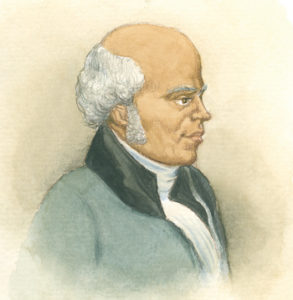
James Varick
The birth of James Varick in 1750 is celebrated on this date. He was a Black Bishop.
He was born to a slave mother in Newburgh, New York, a slave of the Varicks or Van Varcks. She was later freed. His father, Richard, was born in Hackensack, New Jersey, where he was baptized in the Dutch Church. The family lived in New York City while he was young. He acquired an elementary education in New York schools. By trade, Varick was a shoemaker.
Later, he also worked as a tobacco cutter. Since the church with which he was associated did not pay its preachers for many years, he worked at his trades to support himself and his family. About 1790, he married Aurelia Jones. The couple had four sons and three daughters.
The critical events in Varick's life were associated with his religious avocation. He joined the John Street Methodist Church in New York City in 1766, the year after the church held its first meeting. Varick seems to have been licensed to preach by this group. However, he does not appear among the licensed preachers of the early Zion church as given by Christopher Rush, the second supervisor or bishop, in his 1844 history of the denomination. As early as 1780, Black members of the John Street Church held separate classes and prayer meetings. In 1796, Varick was among those Black leaders who established separate meetings on a firmer footing.
The group met for prayer on Sunday afternoons and heard preachers and exhorters on Wednesday evenings in a house in Cross Street, which they remodeled to hold these meetings. Then, in 1799, the group erected a building and formed a separate church. In October of 1800, the African Methodist Episcopal Zion Church, a wooden building at the corner of Church and Leonard Streets, was dedicated. The name of the mother church, Zion, was officially added to the denomination's name in 1848. In March of 1801, the church was formally incorporated under New York law. This incorporation placed the church and its property firmly under the control of the trustees, who were required to be of African descent.
Since the church had preachers but no ordained minister, white ministers preached on Sunday afternoons and Wednesday evenings and supplied a morning communion service on the second Sunday of every month. The church thrived. It acquired a burying ground in 1807 and laid plans to buy the lots it had leased along with another adjacent one and to erect a new brick church to replace the original building. In 1820, as Zion was engaged in erecting its new church, which had the effect of scattering the congregation among many temporary meeting places, a competing Black denomination appeared in the form of Richard Allen’s African Methodist Episcopal Church, which was trying to build up a national organization from its Philadelphia base.
After Zion rebuffed the Allenites, they organized their New York church on Mott Street. Yet not all members of Zion were utterly estranged from the Allenites, and Varick himself opened a meeting for Allen during the dedication ceremonies. Further negotiations between the two denominations failed, however, leaving a considerable amount of bitterness on both sides. After this, Varick reappeared in a leadership role in the Zion church.
In Rush's account, the trustees met at Varick's house in July of 1820 and decided to pursue the ordination of Black ministers, allowing Zion to dispense with white ministers. Varick must have been coming to the fore in church affairs earlier than this, but his name does not appear in the early documents. A general church meeting on August 11, 1820, resulted in two decisions: a refusal to join Allen and a refusal to return to white control. The problem of elders for the separate church now became crucial. On September 13, 1820, Abraham Thompson and James Varick were selected by the congregation to become elders, and they began to act immediately, holding communion services. A book of discipline for the new church was ready for printing by November. The denomination acquired churches outside of New York City, but its growth did not match that of Richard Allen’s group.
At the first convention of the new denomination in June of 1821, Varick was appointed district chairman, an interim supervisory position for the whole denomination. Finally, on June 17, 1822, white Methodist elders ordained Abraham Thompson, James Varick, and Leven Smith. Varick officially became the church supervisor on July 30, 1822, and was reelected in 1824. (The title bishop was not adopted until later.) In addition to his purely ministerial duties, Varick ran a school and church building in his home. He was the first chaplain of the New York African Society for Mutual Relief (1810) and a vice-president of the African Bible Society (1817).
In 1821, he was a member of the group of Blacks who petitioned the state constitutional convention for the right to vote. He supported the establishment of Freedom's Journal, the first Black newspaper, in 1827. On July 4, 1827, the Thanksgiving service for the final abolition of slavery in New York was held in Zion church. On July 22, Varick died at his home. Initially, he was buried in the Colored Union Cemetery (now Woodlawn). His remains now repose in the crypt of the African Methodist Episcopal Zion Church in Harlem.
An Encyclopedia of African American Christian Heritage
by Marvin Andrew McMickle
Judson Press, Copyright 2002
ISBN 0-817014-02-0